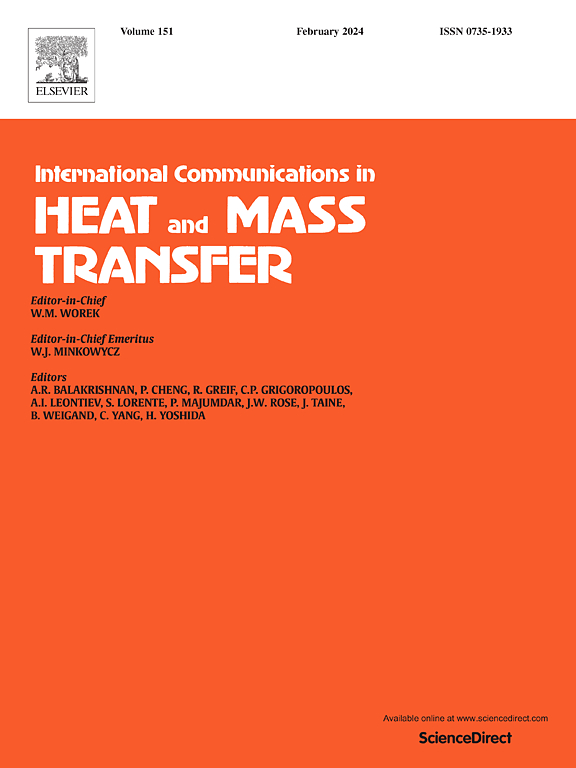The influence of changing pipe cross section on the turbulent flow and heat transfer
IF 6.4
2区 工程技术
Q1 MECHANICS
International Communications in Heat and Mass Transfer
Pub Date : 2025-05-28
DOI:10.1016/j.icheatmasstransfer.2025.109126
引用次数: 0
Abstract
Utilizing a different geometry for a pipe and the consequent increase in turbulency and unsteadiness for flattened pipes can make them a promising candidate for thermal applications. In the present study, the impacts of changing the pipe's cross-sectional area on the near-wall flow for different Reynolds numbers (Re) are investigated. A turbulence model of Large Eddy Simulation (LES) has been employed to numerically investigate the internal fully-developed flow characteristics in both round and flattened pipes. This numerical simulation is carried out inside a round and two flattened pipes with aspect ratios of 2 and 4 and at the Re numbers of 5000, 7500, and 10,000. The numerical data, including Reynolds stresses and Turbulent Kinetic Energy (TKE), is analyzed to determine the influence of the flattening pipe on the flow structure. It has been observed that there is more unsteadiness in the flow characteristics of flattened pipes compared to round pipes at the same Reynolds number and more velocity fluctuations near the wall. Furthermore, a more pronounced development of coherent vortices occurs in flattened pipes, which leads to higher heat transfer coefficients because of enhancing the convection between the fluid and the pipe wall.
改变管道截面对紊流和换热的影响
利用不同的几何形状的管道和随之增加的湍流和不稳定的扁平管道可以使它们成为热应用的有希望的候选者。本文研究了不同雷诺数(Re)下,改变管道截面积对近壁流动的影响。采用大涡模拟湍流模型,对圆管和扁管内部充分发展的流动特性进行了数值研究。在长径比分别为2和4、雷诺数分别为5000、7500和10000的圆形和两个扁平管中进行了数值模拟。通过对数值数据的分析,包括雷诺应力和湍流动能(TKE),确定了扁化管对流动结构的影响。研究发现,在相同雷诺数下,扁平管的流动特性比圆管更不稳定,在壁面附近的速度波动更大。此外,由于流体与管壁之间的对流增强,扁平管道中相干涡的发展更为明显,从而导致更高的传热系数。
本文章由计算机程序翻译,如有差异,请以英文原文为准。
求助全文
约1分钟内获得全文
求助全文
来源期刊
CiteScore
11.00
自引率
10.00%
发文量
648
审稿时长
32 days
期刊介绍:
International Communications in Heat and Mass Transfer serves as a world forum for the rapid dissemination of new ideas, new measurement techniques, preliminary findings of ongoing investigations, discussions, and criticisms in the field of heat and mass transfer. Two types of manuscript will be considered for publication: communications (short reports of new work or discussions of work which has already been published) and summaries (abstracts of reports, theses or manuscripts which are too long for publication in full). Together with its companion publication, International Journal of Heat and Mass Transfer, with which it shares the same Board of Editors, this journal is read by research workers and engineers throughout the world.

 求助内容:
求助内容: 应助结果提醒方式:
应助结果提醒方式:


